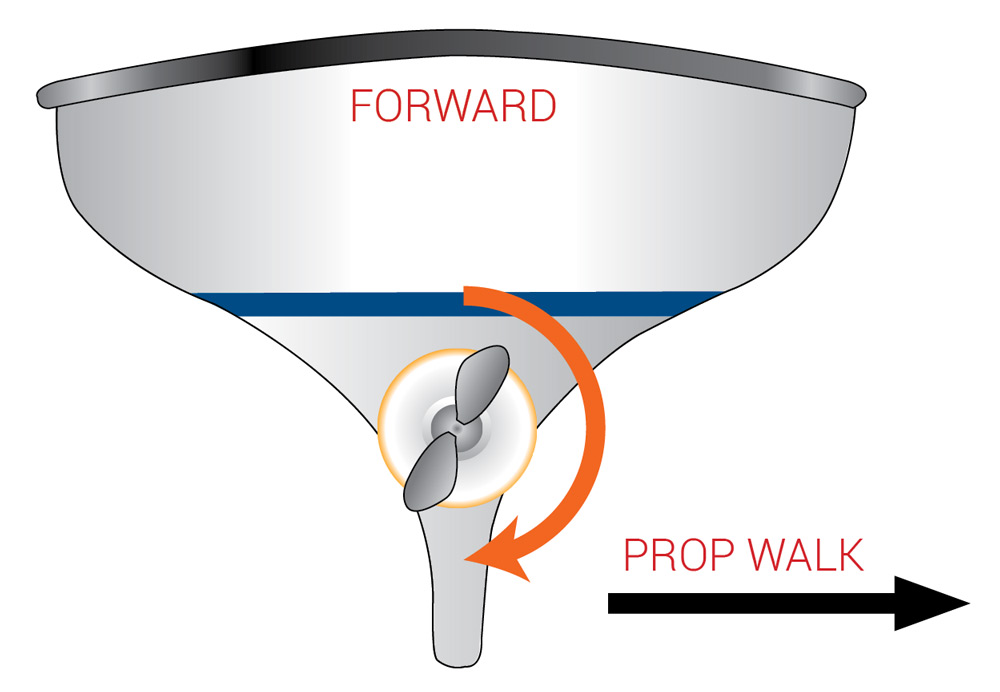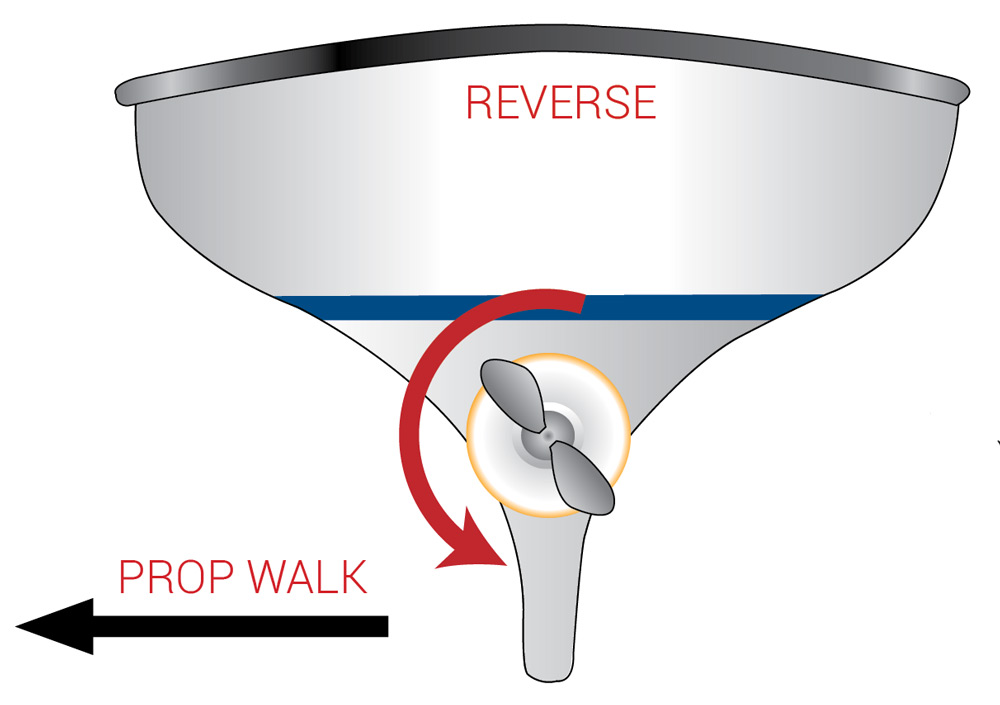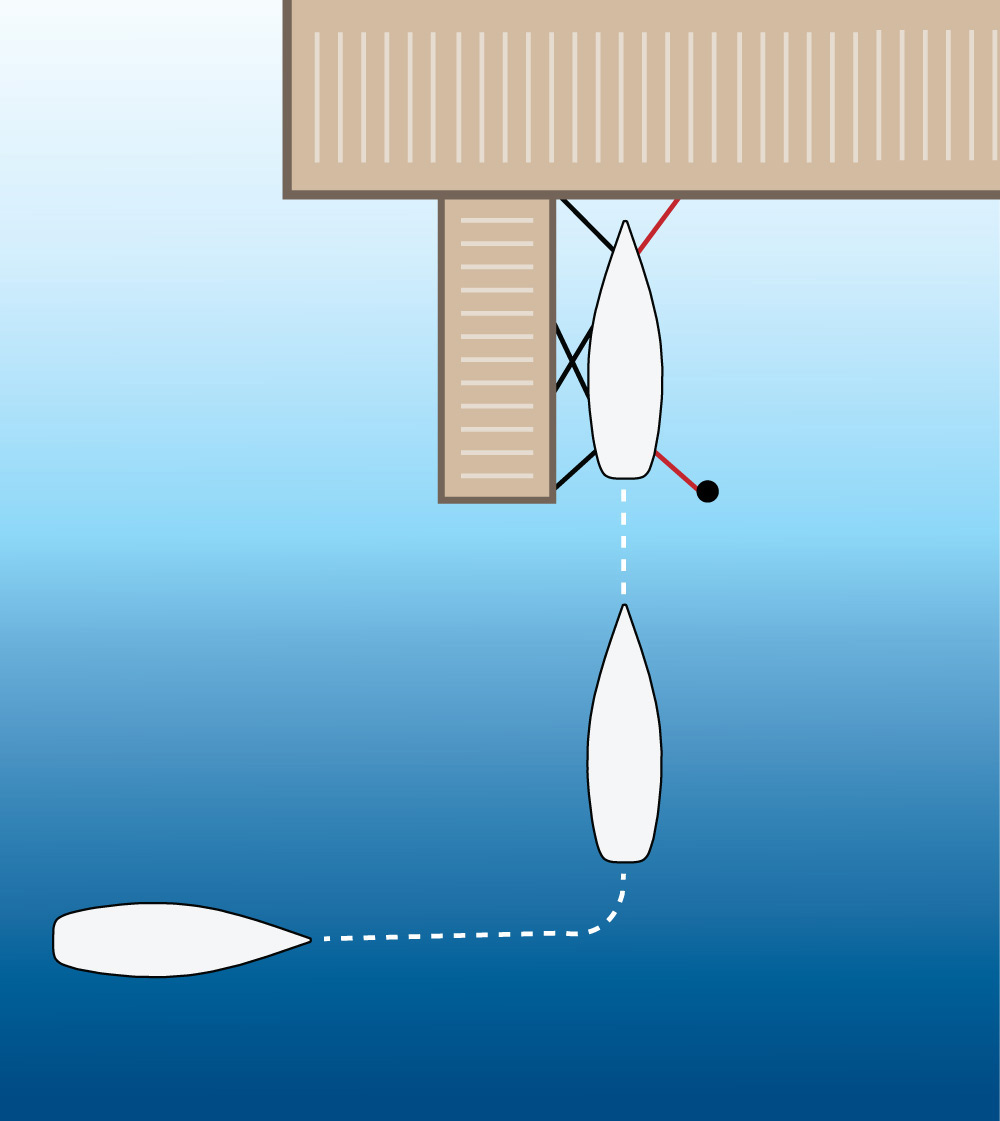Docking under power
Become a docking master by understanding the mechanics at work in getting a boat in a slip
Even the most competent sailor may bristle at pulling into a tight slip with a strong cross breeze. But understanding the mechanics at play in docking a boat make smooth landings far easier.
Sailboats have advantages over powerboats when it comes to slow-speed maneuvering thanks to efficient foils that keep them tracking in a straight line. If there is water flowing over the keel and rudder, even at low speeds, the boat will not slip sideways. But once the flow stops, the keel and rudder will stop providing any directional stability, so a little bit of boat speed is your friend when docking.
The next concept to keep in mine is prop walk, which is the tendency for the stern of the boat to walk to port or starboard when in reverse depending on which way the propeller spins. Most boats will have a right-hand propeller, meaning the propeller spins in a clockwise rotation while in forward. When in reverse, with the propeller spinning in a counterclockwise rotation, the tendency will be for the propeller to walk the stern of the boat to port. This will be an advantage when tying port side to the dock as when you start to slow down with the engine in reverse, the transom of the boat will walk toward the dock. If you are tying starboard side to the dock, the opposite will happen and the transom will walk away from the dock.

Confident docking requires a feel for how a boat behaves under power, both in forward and reverse and at slow operating speeds. Practice maneuvering in open water at first and then move to a nearby mooring field or buoy and practice with a reference point. Get a feel for how quickly the boat will stop at various speeds and check how much prop walk your boat has. I was operating a charter boat a number of years ago and for the life of me, I could not get the boat to back up straight due to the prop walk. I took advantage of the crystal clear water and dove under the 45-foot boat only to find out it had a 18-inch three-bladed fixed prop on it. It became clear to me why it wanted to power sideways instead of backward, given the size of the prop.
Spend a good amount of time getting a feel for how the boat handles in reverse. You want to get a feel for how much power you need to use to stop the boat.
After you get comfortable with general maneuvering and how the boat responds under power, it’s time to head for the dock. Before entering the marina prepare the boat for docking. This includes putting out fenders lined up so that the middle of the fender more or less hits the middle of the dock. You’ll probably have to adjust the height when you get to the dock, so just estimate the placement. You should have an appropriate size and number of fenders for the size of the boat; don’t be the sailor who pulls in to a marina with two undersized fenders.
You will also need to run dock lines. You need a minimum of four dock lines, and you want something like double braid nylon, with a little stretch to it. Lines with a large eye spliced in one end are particularly helpful, as they can be easily tossed over a cleat on the dock for quick attachment. You need lines at the bow and stern as well as a forward and aft spring. The aft spring line is your best friend in docking. This crucial line will help stop the boat as well as bring it alongside the pier. Make sure the dock lines are run under the lifelines and coiled so they can be tossed to the dock if needed.
If you are entering a slip with a piling, you can add an additional bow and stern line on the other side of the boat, but you probably won’t be initially concerned about these lines.

With the lines and fenders set up, you’re ready to dock. Ideally you’ll practice on a day when wind and current aren’t factors. Plan to dock bow-in, as a stern approach has additional factors that are best practiced after you are comfortable with the basics. Approach the dock at slightly more than idle speed. There is a time for higher speed docking, but this isn’t it. You need enough speed to keep water flowing over the keel and rudder so that they are effective.
As you approach a slip, which we assume you’ll have to turn into, make a wide, gradual turn, so you have time to straighten the boat before the bow is even with the end of the pier.
When the boat is lined up with the slip, begin to slow down by putting the boat in reverse, keeping a hand on the throttle and paying special attention to the prop walk. Don’t count on people standing by on the dock to catch a line. Although it can be helpful, the goal is to become confident enough in your docking skills that you’ll be able to manage with just the people on board the boat.
Ideally the boat will be mostly stopped before you begin handling the lines. The first line that should be handled is that all-important aft spring line, which should be made fast to the dock and led to a winch on board so that it can be adjusted to help stop the boat. Even if something went wrong and reverse didn’t work for some reason, the aft spring line will act as the brake. As it becomes taut, it will also pull the boat to the dock.
Get the rest of the dock lines set next. Start with the line that seems the next most crucial, which will probably be the forward spring line or the bow line, and then remaining lines. Remember you can fine tune adjustments on the dock lines after the boat is more or less set, but getting the lines attached to the dock and the boat are the most important.
Once the boat is stopped and all lines are attached to the dock, go back and adjust the height and position of the fenders. Set the fenders at max beam where the boat lies against the dock, spacing them out enough that they will be effective if the bow or stern comes in a bit. They should be mostly clustered, with some spacing at the beam, there’s usually no need for a fender near the bow or stern.
If you have the ability to use bow and stern lines on the non-pier side of the boat, by all means do so. You can attach these as you’re entering the slip if you have enough crew to manage the additional lines, or you can ease the lines a bit to float the stern or bow over to attach to a piling.
It would be wonderful if all landings were done in this perfect-weather vacuum, with light wind and no current, but no sailor is that fortunate. When such obstacles arise, remember one thing: momentum is your friend.
You’ll need a bit more throttle to dock when there are forces working against you, and this is where being comfortable with how the engine responds to the throttle and the effect of prop walk come into play. When facing a strong cross wind that is either going to blow you against the dock or away from the dock, make your initial approach to the dock, before you turn, downwind. This will help provide momentum through the turn and momentum equals control. Things can go badly pretty quickly if you get halfway into a slip with little speed and the wind takes your bow one direction or the other.

Use enough speed to keep the bow pointing in the direction you want it to go. If you feel the bow drifting, nudge the throttle a bit. This is not to say that you should gun it, because there is a fine line between control and crashing into the dock.
And of course, the more throttle you use going forward, the more reverse you’ll need, so be ready to apply a lot more reverse throttle than you would in a no-wind landing.
Line handling becomes more important in challenging docking conditions, and it will likely become quickly apparent which dock lines are the most important. As soon as you stop the boat, the bow is going to start moving, so be swift with the bow line right after, or simultaneously, if possible, you get the aft spring under control.
Challenging docking can be a gut check for every skipper, and there’s no better cure than practice. Pulling the boat into the slip can become second nature, you just need the practice to get there.

Comments